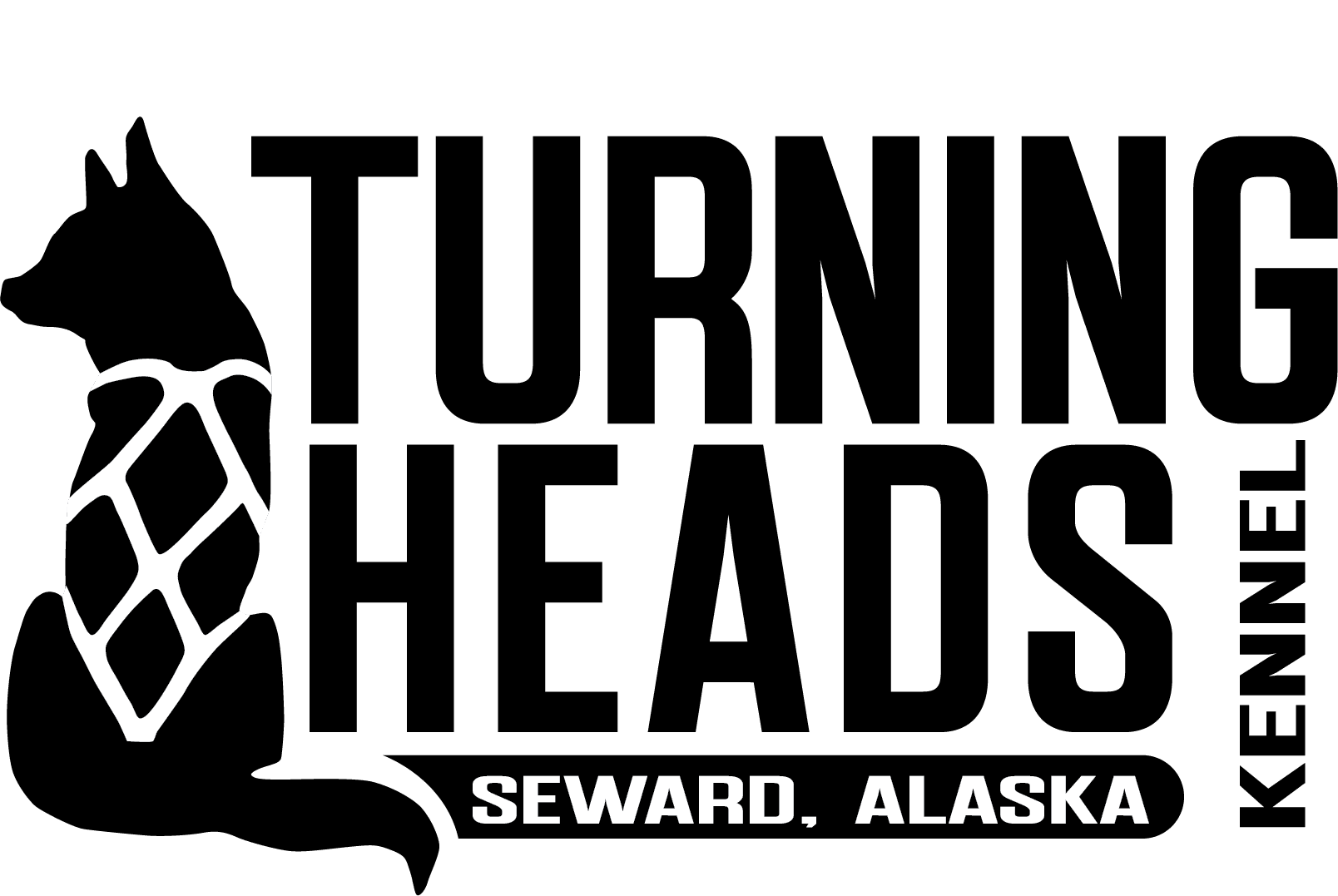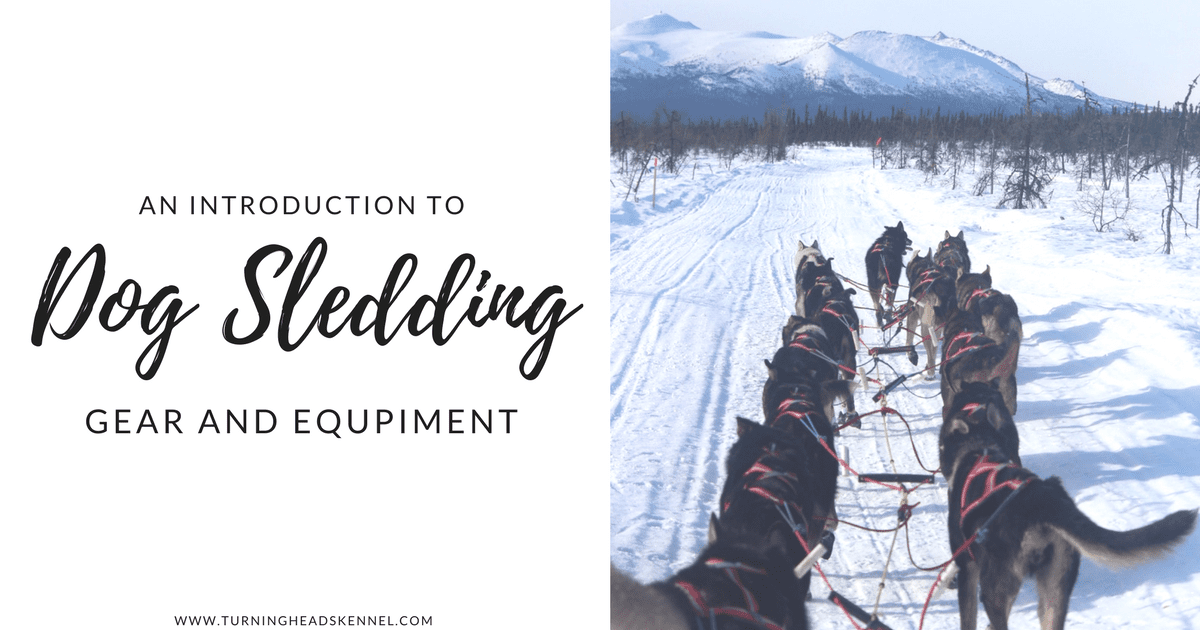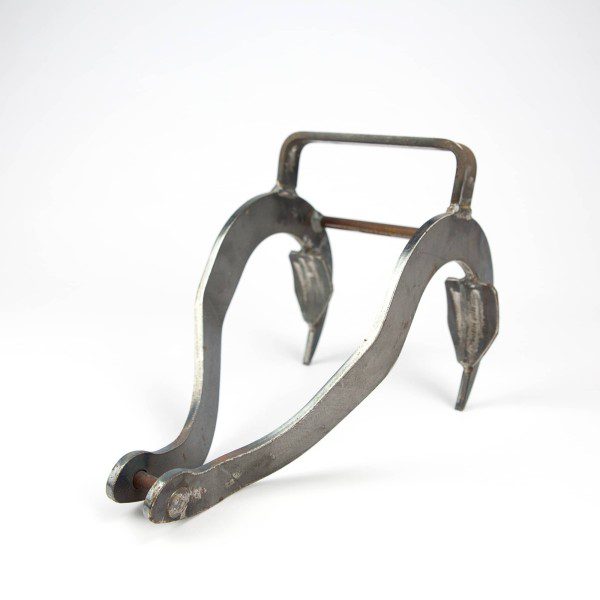A lot goes into owning and operating a kennel full time. In order to take great care of our sled dogs and in order to mush, a lot of different gear is required. Knowing the different equipment used in the sport of dog sledding is an important first step in understanding the sport. Not only are there different tools used to run dogs but there is also the different gear that the dogs themselves have. In this blog post, we go over the basic mushing gear.
Mushing Equipment
Dog Sled
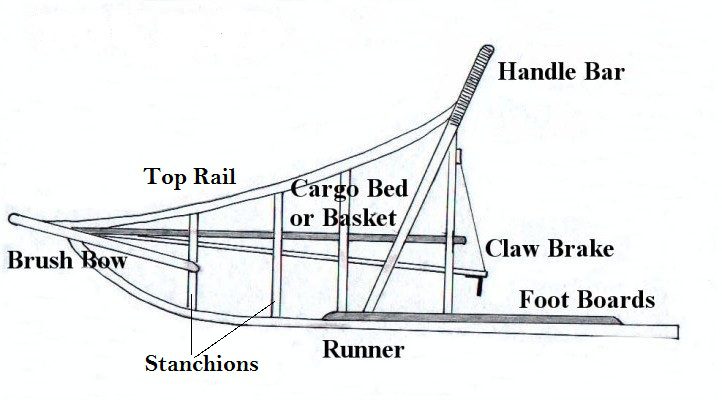
The quintessential piece of dog sledding equipment, besides the dogs of course, is the dog sled. Today there are many different styles of dog sleds built out of different types of material. Sleds are built differently depending on the use. Sleds with larger beds are generally “expedition” style sleds designed for mid and long distance races and the training that they involve. The bigger beds allow mushers to carry the necessary gear needed for spending time on the trail. Sleds for sprint racing are generally much smaller and nimbler.
Sleds are commonly made out of wood, carbon fiber, and aircraft aluminum. Materials need be both tough and lightweight – we don’t want our dogs pulling weight they don’t need to be!
Brushbow
The brushbow is like the front bumper of the sled.
Bed
The bed is the flat part of the sled that is used for storage and hauling gear. Generally sleds used for long distance mushing will have a longer bed than those used for sprint racing.
Runners
The runners are what the sled sits on.
Brake
The brake is used to stop the team. There are several different styles of brakes made by various companies. We’ve found that the best brake we’ve ever used
Dragmat
The dragmat is the speed control of the team.
ATV
Using an all-terrain-vehicle, more commonly referred to as an ATV or “quad” is an important part of training in modern day dog mushing. Using an atv allows dog mushers to work with their teams long before their is snow on the ground thus allowing the mushing season to begin considerably earlier. Many mushers in Alaska are able to start training in early September. This earlier training allows the dogs more time for conditioning and greatly contributes to the success of the team. More training allows us to work with our dogs and further develop their abilities.
ATVs are also a valuable tool when it comes to training lead dogs. Because atvs have both throttle and brake, mushers are able to give very direct feedback to their lead dogs. If the lead dogs get a command right, the musher will give a little gas as positive reinforcement — for sled dogs, going fast is a reward. If the lead dogs do not get the command given correct, the musher will hit the brake as a negative reinforcement — sled dogs want to run, so stopping is bad and considered punishment.
Gangline, Tuglines, and Necklines
The gangline is the main line that the dogs are attached to. The gangline is generally made out of thick cable, though sometimes that cable is covered by rope. Gangline sections range in length depending on the style of harness the musher is using on their dogs and their.
Tuglines are the lines that connect the back of the harness that the dog is wearing to the gangline. Whether the tugline is taught or not will depend on if the dog is pulling. The neckline is the line that runs from a dog’s collar to the gangline. This line isn’t used for pulling, rather it is used to help keep the team organized moving down the trail. Some mushers elect not to use necklines while moving down the trail. Necklines are also used when teams stop and rest on the trail or in checkpoints. When it is time to rest, a musher will remove the tugline but will keep the neckline on. This allows the dog freedom of movement while still being secure.
Snowhook
The snowhook is the anchor that hold the dogsled and dog team back when the musher decides to stop along the trail. It is like the parking break for the dog team — though somewhat less reliable. It looks and works like a giant fishhook. Theoretically, the harder the team jerks on the snowhook the more the hook digs into the ground, thus securing the team. The reality of this, however, is that occasionally the team will pull hard enough that the snowhook will pop free.
Sled Dog Gear
Alaskan winters can see extreme temperatures. The better care we take of our sled dogs, the better care they will take of us when we are out on the trail. We use all sorts of different pieces of gear on our sled dogs to help them perform their jobs and to keep them healthy and safe.
Harnesses
Harnesses are sized according to the dog. There are several different styles of harness currently available for sled dogs. Every musher has their preference that they think is “the best” and results in the most pull and the least amount of injury. Here are some common harness types: X-back, H-back, Half-harness, and spreader bar harness. Different harnesses have things they do best. Spreader bar harnesses are thought to add more power whereas half-harnesses are believed by some mushers to result in fewer athletic injuries.
Booties
Booties come in multiple different sizes and most dogs wear one size on their front feet and a different size on their back feet. Whenever we are racing or training the dogs, whether in the fall or winter, you will almost always see the dogs in booties. The purpose of the booties is to help prevent the dogs from getting cuts on their feet or from having snow ball up between their toes.
These booties get replaced just about every run as they only last about 60-80 miles. On average, we go through about 4000-5000 booties a year. At 90+ cents apiece, our dogs spend more on footwear per year than we do! Some popular brands of booties are from dogbooties.com, Kipmik products, and Mountain Ridge.
Ensuring proper fit is important too. Booties that are too big are uncomfortable or may fall off while running. Booties that are too small may restrict blood flow. Because of the importance of booties play in protecting the feet of sled dogs, most mushers choose to remove the back dewclaws of their dogs when they are 2-3 days old. Having back dew claws can result in painful rubs.
Here is a great video Aliy Zirkle put together from 2010 talking about dog booties.
Dog Jacket
All dogs differ in their ability to tolerate the cold. Sled dogs are generally alaskan huskies, Siberian huskies, or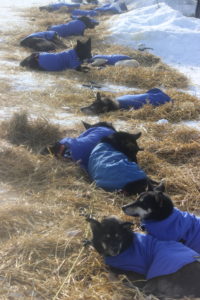 malamutes all have a double layer fur coat that helps keep them warm. Sled dogs prefer colder temperatures and generally don’t require help staying warm until temperatures are approximately -20F (-28C).
malamutes all have a double layer fur coat that helps keep them warm. Sled dogs prefer colder temperatures and generally don’t require help staying warm until temperatures are approximately -20F (-28C).
Dog jackets act as a track suit for our dogs. They wear them while they rest to help keep their muscles nice and warm and they also can wear them while they run. As fabric technology has developed, so too have our jackets. They are now generally sewn using windproof and waterproof material. Once bulky, they now are lightweight and compact — which is extremely helpful when packing a dogsled for a long distance endurance race.
Male Wrap
When it’s cold out our male sled dogs need help ensuring that they do not develop frostbite on their penis. A dog’s penis is normally protected by the penile sheath (the prepuce). Both the penis and penile sheath can get frostbite and prevention is a crucial component of good dog care. The development of frostbite in this area is extremely painful and requires immediate attention as it can develop into condition called paraphimosis. Paraphimosis is when the penis cannot go back into the sheath and can lead to further medical complications.
The best method of preventing frostbite is by using a male wrap, sometimes more commonly referred to as a “pecker protector” by mushers. Fur is often used because when dogs pee on it, it does not stick and ice up. Synthetic material may also be used if it is windproof and waterproof. It is important that if males pee on the wrap that the urine does not stick to them so that ice does not build up. As mushers, we most constantly check the male wraps and “deice” them if necessary or put a new wrap on.
Males can develop frostbite even in moderate temperatures if there is a female in heat (a female capable of being bred) in the team. When females are in heat, the males may get excited and the penis will extend out of the sheath, making it more likely for them to develop frostbite. Mushers must be aware of this when they take their teams out into colder conditions. Sometimes, it may be easier to remove a female in heat from the team than to worry about the problems having her in the team may create.
Belly Wraps
Mushers also need to be careful with our females, especially those who have had pups, that they do not get frostbite on their teats as this is very uncomfortable and can be a reason a female could get dropped. So to help keep their undersides, where the dogs have less hair, we use belly wraps. Generally the belly wraps are made out of the same material as our dog jackets or are made out of fleece. Some dog jackets have belly wraps built in.
Leggings
Snow conditions vary wildly during the winter. In colder temperature, snow can be quite abrasive. When the dogs are running, the abrasive surface can cause our dogs to lose hair on the backs of their front legs. When a dog develops this, mushers may refer to it as “chicken leg.” The best course of action is always prevention. That, is where leggings come in. Leggings are wraps worn on the front legs of a dog. They may be made out of fleece or ripstop fabric and conditions may warrant the entire team to wear them or they may only be put on as needed.
Camping Gear
Straw
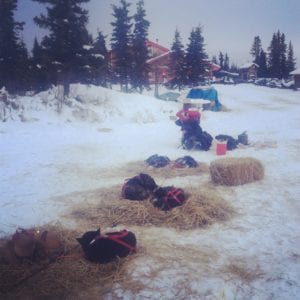
When out on the trail, straw is used as simple bedding for sled dogs. Straw is used to elevate the dogs off of the snow and ice and acts as a bed and insulator. Typically, races provide straw for mushers at checkpoints as it helps keeps dogs warm and improves their ability to rest and recover. Mushers can choose to use all the straw they are given or to keep some of it to carry further down the trail and to use outside of the checkpoint to camp remote. During the Iditarod, mushers are given one bale of straw per checkpoint.
Straw is also used to help insulate dog houses during the winter. Mushers typically put straw in houses and change it every one to two weeks.
Cooker
A cooker is used to melt snow to create water for the dogs. It consists of an outer pot or shell where fuel is put and the fire is made and an inner pot where snow is put to be melted. In mid and long distance dog sled racing, it is considered mandatory gear.
Zens Stoves provides the following summation on the cookstove musher’s use while on the trail.
The stove of choice for mushers is an alcohol stove running on yellow HEET methanol. This type of stove has a simple design without any moving parts with good protection from the wind and cold. It will dependably melt snow and heat up your meal in weather so cold that gas fuels will fail. And without moving parts, your life doesn’t depend on how well you can maintain your stove when your fingers are frozen, your brain is numb and your eyes are blinded by the eternal darkness of winter concealed in a haze of a blizzard.
When camping with a dog team on the trail, mushers use the cooker to make water for the dogs and to melt meat. There are many different cooker styles in use today. Some cookers are square or rectangular while others are cylindrical. The goal in cooker design is to maximize the efficient heat transfer from the fire to the snow. The quicker the snow can melt into water and then boil, the faster a musher can feed their dogs. The quicker a dog team can eat, the quicker they can get to bed to begin digesting their food and recovering from the previous run. Cookers are meant to be very basic — we don’t want anything breaking out of the trail.
As a rule, most mushers do not put anything besides snow or water into their cooker. This is done as a safety precaution for both dogs and humans. In the event of an emergency, if a musher needs to use their cooker to make drinking water for themselves, they do not want it contaminated by raw meat. Additionally, using the cooker only for water ensures its cleanliness and helps limit the spread of bacteria.
In recent years, many mushers have tried adopting cookers that could be used while moving down the trail. Although these designs have seen some moderate success, their has yet to be a foolproof way to melt snow on a jostling sled thats going down the trail. When an approach is developed that is both safe and efficient, it will likely be a game-changer in the evolution of long distance endurance dog sled racing.
Cookers are not only used to prepare food for the sled dogs — they are also used to help prepare the food for the musher while out on the trail. Musher may eat either frozen or dehydrated meals out on the trail: frozen meals are reheated in the cooker as the water warms for the dogs and water bottles may be put in to heat up water for dehydrated meals.
Heet
HEET is the fuel source of choice for mushers and for dog sled races when out on the trail. HEET is usually![]() used as a means of getting water out of the fuel line in vehicles during the cold winter months. It is an ideal fuel source because it is relatively easy to carry and is not effect by cold temperatures.
used as a means of getting water out of the fuel line in vehicles during the cold winter months. It is an ideal fuel source because it is relatively easy to carry and is not effect by cold temperatures.
Generally mushers will carry this while they are camping or racing. Many races specify how many bottles of heet a musher must carry as mandatory gear because without it, a cooker is of little use.
https://youtu.be/rgPUpvTqqAA
Travel Dishes
Just like we have travel mugs, our dogs have special lightweight travel dishes. Most mushers use a heavyweight durable plastic dish that is stackable and easy to wash. When on long endurance races, mushers may swap out sets of dishes every few checkpoints to help ensure cleanliness.
